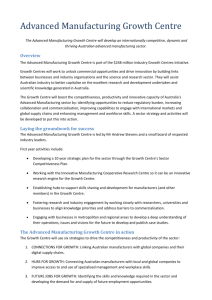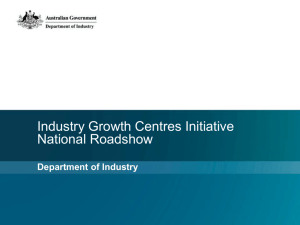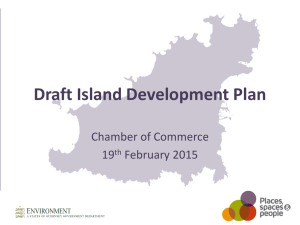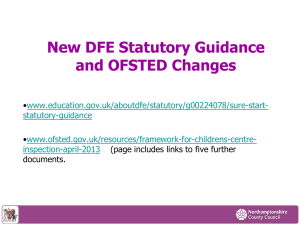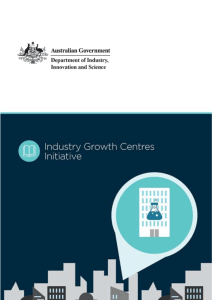Consultation session presentation slides (PPTX
advertisement
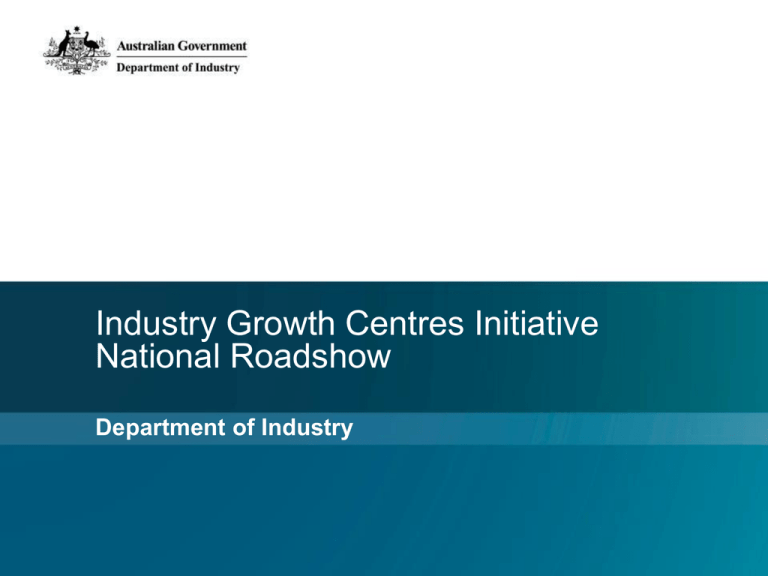
Industry Growth Centres Initiative National Roadshow Department of Industry The need for a Reform Agenda Australia is falling behind Advanced countries are aggressively reforming their economies Reducing the cost of doing business Strengthening networks and linkages Improving the performance of the innovation system as a whole Focusing on system failures in addition to market failures Australia ranks Poorly in regards to overall competitiveness 23 out of 26 OECD countries for businesses collaborating on innovation Last out of 30 OECD nations for business – research collaborations 81 out of 143 countries on the how effectively we get returns from research An action plan for Australia’s future The reform agenda The Industry Innovation and Competitiveness Agenda released on 14 October 2014 is: The key business-focussed element of the government’s Economic Action Strategy Focused on economic settings and incentives to enable strong businesses to grow Capitalising on Australia’s strengths, creating jobs, and exploiting our nation’s competitive advantages Equipping businesses and employees with skills to succeed Creating a nimble economy able to adapt to changing economic conditions and seize new opportunities Four ambitions of the Agenda Ambition 4: Industry policy that fosters innovation and entrepreneurship Reshaping industry policy and focusing research spending to stimulate innovation and entrepreneurship, improve competitiveness, and create new job opportunities New Industry Policy A sector based approach to drive growth, productivity and competitiveness in Australia’s industries Strong alignment with contemporary industry policy thinking internationally United States’ Small Business Administration’s regional cluster initiative Canadian business-led networks of Centres of Excellence United Kingdom’s Catapult Centres A sector based initiative will: Enable key growth sectors within the Industry portfolio to become self reliant and grow Position Australia as a world leader to tackle competitive pressures through collaboration Ensure our key growth industries can deliver the economic prosperity needed in a globalised economy Building on Australia’s competitive strengths A sectoral approach to industry policy is not about picking winners or protecting industries Targeted and strategic investment, prioritising limited government resources to remove impediments in areas of Australia’s competitive strengths Sectors where Australia either enjoys a comparative advantage, is currently internationally competitive, or is likely to have an opportunity to exploit favourable global market developments or has a significant impact on the Australian economy within the Industry Portfolio are: Food and Agribusiness Mining Equipment, Technology and Services Medical Technologies and Pharmaceuticals Advanced Manufacturing Oil, Gas and Energy Resources Industry Growth Centres Initiative Key features of the Initiative: New $188.5 million industry policy to boost productivity and competitiveness Initial five Industry Growth Centres to be established in key industry sectors Also comprises: Industry Growth Project Fund Industry Growth Network Commercialisation Fund –delivered through Entrepreneurs’ Infrastructure Programme Will complement and leverage existing State and Territory innovation and collaboration programmes Industry-led so your involvement is essential Industry Growth Centres activities The Initiative will provide a framework to transition industry to high value added products and services in areas of competitive strengths The Initiative will establish an initial five industry-led Growth Centres that will address four key themes: Regulatory Reform Access to markets and value chains Improving Skills Fostering collaboration and commercialising research The framework provides flexibility for Industry Growth Centres to deliver sector specific activities but common activities include: Competitiveness plans Regulatory reform plans Industry knowledge priorities Industry skills strategies Potential Growth Centre activities Food and Agribusiness Improve SMEs capability to access export markets through specialist training & advice on target markets. Mining Equipment, Technology and Services Facilitate field trials for Australian technology on mine sites. Medical Technologies and Pharmaceuticals Advanced Manufacturing Bring researchers and companies together to develop best practice processes for identifying and developing prototypes or drug candidates, to improve the commercialisation of potential therapeutic products. Investigate opportunities to speed up regulatory approval processes for industrial chemicals manufacturing by ensuring approval processes are appropriate given the level of risk. Oil, Gas and Energy Organise inbound trade missions of key procurement personnel from international project developers to explain global supply chain access requirements and showcase Australian supply capability. Industry Growth Centres A non profit business staffed by a small and experienced management team with shared back office services for all Centres Governed by strategic Industry–led five person Board tasked specifically to develop and implement a competitiveness agenda An overarching Board will provide external advice to the Minister on strategic policy matters and performance related to the Industry Growth Centres Each Industry Growth Centre will have operational funding of $3.5 million per annum to support basic activities and services Industry Growth Centres will be funded for a four-year period and are then expected to be self-sufficient Industry Growth Centres will engage with the sector to establish a national network A focus on science and research The Initiative aligns with the Australia’s Chief Scientist recommendations outlined in the position paper, Science, Technology, Engineering and Mathematics: Australia’s Future The Initiative will: Increase the transfer of knowledge between researchers and business by fostering collaboration Increase industry demand driven research by the identification of industry knowledge priorities to inform national research priorities Improve the translation of publically funded research into commercial outcomes to help drive innovation Target STEM skill gaps in the key industry sectors Collaborating for impact The Initiative will establish a $63 million Industry Growth Project Fund The project fund will support collaborative infrastructure by: Supporting large scale collaborative projects to provide targeted actions to build capability and competitiveness of the sector Benefiting the sector as a whole and not just project participants Focusing on market, value chain or technology issues Requiring matched industry funding The project fund will : Be for exclusive use by the Industry Growth Centres Be awarded through a merit based process Not fund basic or discovery type research Further consultation will occur in 2015 Industry Growth Centres Selection Process Proposed schedule of events Chairs of Industry Growth Centres to be announced by government Engagement with sectors to establish Industry Growth Centres commences early 2015 The Chair and Facilitator will work with the sector to form one proposal for each Industry Growth Centre Industry Growth Centre proposals approved by Minister for Industry Staggered establishment of Industry Growth Centres starting early 2015 Anyone can be involved in the engagement process and when the Industry Growth Centres are operational. Interaction with Entrepreneurs’ Infrastructure Programme Further details about how to be involved in Industry Growth Centres Initiative are available on the website: www.industry.gov.au/growthcentres DEPARTMENT OF INDUSTRY Industry House 10 Binara Street Canberra City, ACT 2601, Australia Telephone +61 2 6213 6000
